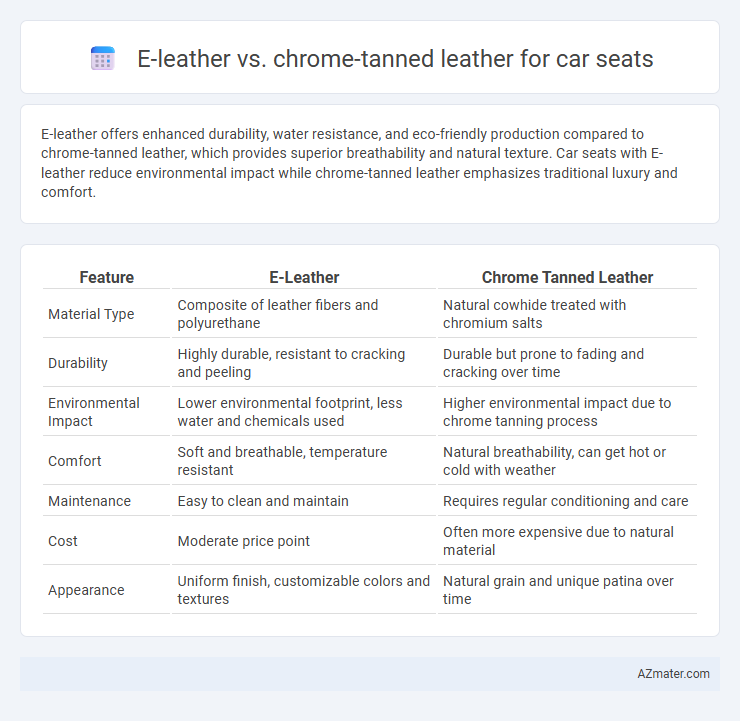E-leather offers enhanced durability, water resistance, and eco-friendly production compared to chrome-tanned leather, which provides superior breathability and natural texture. Car seats with E-leather reduce environmental impact while chrome-tanned leather emphasizes traditional luxury and comfort.
Table of Comparison
| Feature | E-Leather | Chrome Tanned Leather |
|---|---|---|
| Material Type | Composite of leather fibers and polyurethane | Natural cowhide treated with chromium salts |
| Durability | Highly durable, resistant to cracking and peeling | Durable but prone to fading and cracking over time |
| Environmental Impact | Lower environmental footprint, less water and chemicals used | Higher environmental impact due to chrome tanning process |
| Comfort | Soft and breathable, temperature resistant | Natural breathability, can get hot or cold with weather |
| Maintenance | Easy to clean and maintain | Requires regular conditioning and care |
| Cost | Moderate price point | Often more expensive due to natural material |
| Appearance | Uniform finish, customizable colors and textures | Natural grain and unique patina over time |
Introduction to Car Seat Materials
Car seat materials primarily consist of E-leather and chrome-tanned leather, each offering distinct characteristics for automotive interiors. E-leather, or eco-friendly leather, combines synthetic fibers with natural leather to enhance durability and reduce environmental impact, while chrome-tanned leather provides a traditional feel with superior softness and aging properties due to its chromium sulfate tanning process. The choice between E-leather and chrome-tanned leather significantly affects comfort, maintenance requirements, and sustainability in car seat design.
What is E-Leather?
E-leather, also known as engineered leather, is a synthetic material made by bonding leather fibers with polyurethane, offering a more sustainable and cost-effective alternative to chrome tanned leather for car seats. It provides enhanced durability, resistance to wear and tear, and easier maintenance while replicating the look and feel of traditional leather. Unlike chrome tanned leather, E-leather significantly reduces environmental impact during production by minimizing chemical usage and waste.
Understanding Chrome Tanned Leather
Chrome tanned leather, widely used in car seats, is processed using chromium salts, enhancing its durability, water resistance, and softness compared to traditional vegetable tanning methods. This method allows for faster production times and results in leather that retains color vibrancy and resists cracking under varying temperatures. Understanding chrome tanned leather's properties helps in comparing it with E-leather, which is synthetic, offering different benefits such as animal-free sourcing and easier maintenance.
Environmental Impact Comparison
E-leather for car seats significantly reduces environmental impact by utilizing synthetic or plant-based materials that avoid harmful chrome tanning processes, which emit toxic waste and heavy metals. Chrome tanned leather involves chromium salts that pose serious pollution risks to water and soil, contributing to hazardous waste and higher carbon footprints in leather production. Opting for e-leather supports sustainable automotive interiors by lowering chemical pollution and resource consumption compared to traditional chrome tanned leather.
Durability and Longevity
E-leather for car seats offers enhanced durability due to its synthetic composition, making it resistant to wear, stains, and UV damage compared to traditional chrome-tanned leather. Chrome-tanned leather, while providing a luxurious and natural feel, is more prone to cracking and fading over time, especially under harsh sunlight exposure. E-leather's resistance to moisture and temperature fluctuations contributes to a longer lifespan, making it a practical choice for car interiors requiring high durability and longevity.
Comfort and Aesthetics
E-leather offers superior breathability and flexibility compared to chrome-tanned leather, enhancing overall comfort during long drives by reducing heat buildup and moisture retention. Its uniform texture and consistent coloration provide a sleek, modern aesthetic that resists fading and cracking over time. Chrome-tanned leather delivers a traditional, luxurious appearance with rich patina development but may feel stiffer and less breathable, impacting seat comfort in varying temperatures.
Maintenance and Care Requirements
E-leather for car seats demands less maintenance and resists stains better than chrome tanned leather, making it ideal for busy households. Chrome tanned leather requires regular conditioning and cleaning to prevent cracking and fading due to its natural fibers. Both materials benefit from avoiding prolonged sun exposure, but e-leather handles moisture and spills more effectively, reducing the need for intensive care.
Cost and Affordability
E-leather offers a cost-effective alternative to chrome tanned leather for car seats, typically priced 20-40% lower due to its synthetic manufacturing process, which reduces raw material expenses. Chrome tanned leather entails higher production costs because of the extensive use of chromium salts and natural hides, making it less affordable for budget-conscious consumers. Affordability of e-leather makes it a popular choice in mass-market vehicles while chrome tanned leather remains preferred in luxury models due to its durability and premium feel.
Safety and Health Considerations
E-leather used in car seats is often free from harmful chemicals like formaldehyde and heavy metals, reducing health risks such as allergic reactions and respiratory issues. Chrome-tanned leather, although durable and flexible, involves chromium salts in the tanning process, which can pose environmental and toxicity concerns if not properly treated. Choosing E-leather enhances safety by minimizing exposure to toxic substances while maintaining comfort and durability in automotive interiors.
Which is Better for Car Seats?
E-leather, made from eco-friendly polyurethane, offers superior durability, resistance to stains, and easier maintenance compared to chrome-tanned leather, making it a practical choice for car seats. Chrome-tanned leather provides a luxurious look and natural breathability but requires more care and is prone to wear and discoloration over time. For car seats, e-leather is often considered better due to its enhanced longevity, environmental benefits, and cost-effective upkeep.

Infographic: E-leather vs Chrome tanned leather for Car seat
 azmater.com
azmater.com